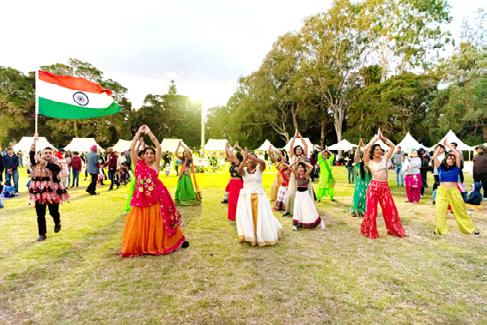
17 minute read
Happy 73rd, India!
from 2019-08 Sydney (2)
by Indian Link
Sydney’s Indian community boasts many ways to celebrate India’s Independence Day


For more pics of all events, head to our Facebook page (IndianLinkAustralia)
BY PAWAN LUTHRA
Uia
Leading from the front this year was the Mateship Fair by the United Indian Associations (UIA), heldon the banks of the Parramatta River. It led from the front solely because it was the first in a long series of similar events – not, mind you, because of any claims to quality. Strangely lacklustre, it seemed like a tick-thebox kind of show, sadly. Not sure what the box was about, either – with no real mateship on display in terms of the features included. The only mateship with mainstream Australia was with a bunch of Brazilian dancers in their Samba costumes, who for some inexplicable reason, won the honour of leading the annual parade this year. The stage with invited special guests outnumbered the people sitting in the audience. UIA needs to get past its desire to felicitate and honour members of the community at all their gatherings: rather have a systematic and transparent method as to nominations and selections of awardees.
The crowds looked to be down from last year. A large number of those attending were cultural show participants and their families and wellwishers. As the options for the free community melas/fairs increase, consumers will become selective of where they want to go. Unless the organisers can come up with exciting options to entice the crowds, sadly these fairs will have declining numbers.
The Indian community and its well-wishers get together on a variety of platforms to mark India’s Independence Day. By the looks of it, there are more celebrations by the diaspora here than by the citizens in India. Whereas in India, the day is a national holiday with the highlight being the Prime Minister’s speech at the Red Fort in Delhi, in Australia, particularly Sydney, the celebrations start early as the various associations vie to endorse their brand of patriotism in their own way. In the recent past, even Local Councils have got in the fray.
The summary above may well be repeated for the Federation of Indian Associations of NSW (FIAN) event held on 10 August. There were no Brazilian dancers to be seen – which was probably a good idea as it turned out to be one of the coldest days of the year in Sydney. Yet even the icy winds causing the temperatures to plummet could not put down the spirit of the indomitable Yadu Singh, President of FIAN, who declared, “Think about the soldiers who have to endure this cold weather in the mountains of the Himalayas: we need to acknowledge their sacrifices.”
Some politicians from both sides of the Parliament abandoned their traditional Indian wear on this occasion,choosing to be warmly clad in their heavy jackets and overcoats, although the odd sari was visible (we’re looking at you, Jodi McKay). Footfall was well down – community wallahs preferring their hot chai in their blankets at home rather than out in the cold.
Cia
It seems that the Council of Indian Australians (CIA) had the best idea of all. Rather than the grounds of Parramatta, they chose to celebrate India’s 73rd Indian Independence Day with a sit-down dinner at the Pioneer Theatre in Castle Hill, all warm and cosy. With just over 270 guests, the evening was immaculately organised and executed. The team behind CIA, led by President Nitin Shukla, ensured fun and bonhomie for all those in attendance. Being a costed event as compared to the free melas, there was access to funds, which allowed the organisers more flexibility with their programming. Setting the tempo were the wonderful dance performances by the Swastik Dance Group. A blend of traditional and Bollywood dances, the fusion performances were delightful and even set the mood for a few of the invited special guests such as the Consul General of India Manish Gupta and wife Nimisha, NSW Labor leader Jodi McKay, her colleague Julia Finn, Shadow Federal Minister Michelle Rowland, Parramatta Councillor Sameer Pandey and others to put their dance moves on display. There were more than a few talented dancers on stage–and some that should perhaps hang on to their day jobs.

What was lacking that evening though, was a greater flavour of things patriotic that CIA has been known for in the past.
Consulate General Of India
15 August is a day on which the Indian government celebrates the birthday of modern India. At every Indian mission and consulate, the morning celebrations include the unfurling of the Indian tricolour and a reading of the message of the President of India.In Sydney, over 250 people gathered to hear the new Consul General Manish Gupta do the honours for the first time. Yet like very time, the celebrations were solemn and dignified as the occasion and the venue, suitably bringing out the ‘Indian’ in us, many thousands of kilometres away from India. With Mahatma Gandhi looking on in the background at his non-resident countrymen, many photos were clicked and the community mingled with the representatives from the Government of India. Miniature Indian flags were distributed and traditional South Indian breakfast served as the sounds and smells transported us all back to India.
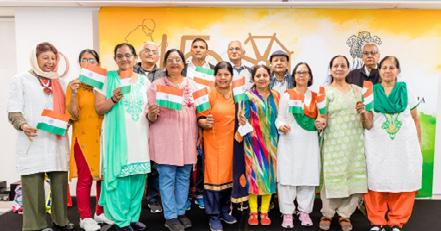
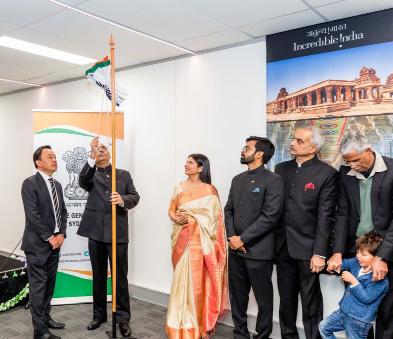
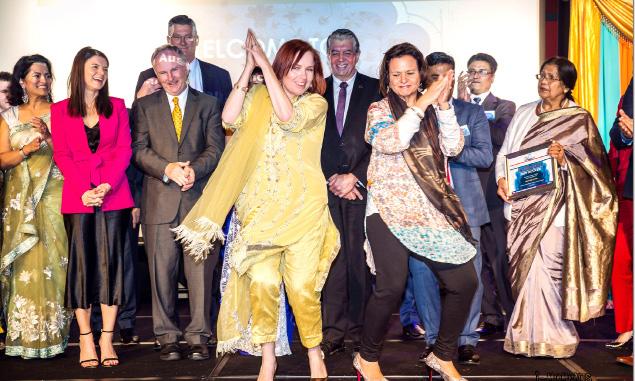
City Of Parramatta
The Indian tricolour was hoisted yet again immediately after, this time a few kilometres away from the Consulate offices. At an event hosted by the City of Parramatta, Lord Mayor Andrew Wilson welcomed the Indian community in his locality to acknowledge their national day. In what turned out to be a bright and sunny week day morning, some 600 people rocked up for the outdoor ceremony to feel the call of the motherland. What they got, though, was something much more – they gained a broader, more inclusive sense of their happily dual identities. Watching the Indian and the Indigenous dancers, singing the national anthems of both India and Australia, and saluting both national flags, brought a wonderful sense of pride in, and celebration of, the two cultures that together afford us a sense of home. Indian Consul Nandakumaran Konnat joined the Lord Mayor in leading the proceedings.


Indian Consulate Gala

The celebrations by the Consulate General of India continued in a more formal gathering in the evening as the Consul General Manish Gupta hosted a reception for selected members of the Indian community at the salubrious Sofitel Wentworth hotel. In attendance also were members of other diplomatic corps in NSW, and many state politicians and business leaders. Though the Governor of NSW Margaret Beazley was invited, she could not attend, leaving her Official Secretary Michael Miller, RFD and husband Dennis Wilson to join the festivities instead. With the women in their resplendent saris and the men in their suits and national dress, it was a great way to finish the celebrations.

In a strange way, the amalgamation of the melas, the dinner, the flag hoisting, the public square festivities and the formal reception, all added to the sense of the occasion.

Viewfinder
BY GURMEET
This is the very essence of parenting - suspended and committed. Observed wildlife teaches us the basic patience, knowledge about the animal's behaviour and some specific technical skills to capture the moment. giving enough time to capture them in action. The trigger for me to take this photo was that the juvenile will start shutter speed in burst mode Shot on a Nikon D750 and
Viewfinder
GURMEET KALSI ethics of life and to me, a photographer, it can be quite a spiritual experience. Photographing wildlife takes moment. I had to commit a lot of time with these Welcome Swallows as they are very swift and fast moving birds, not start to flutter its wings as soon as the parent bird is around with the food in its beak. The shot was taken at fast (f8; ISO 1000; 1/1250 sec). and Tamron 150-600mm lens
Massive decline in India in coal power project lending
FA financial assessment this month has revealed a 90 per cent decline in coal power investment in India in 2018 compared to the previous year.
"Coal vs Renewables 2018" - an annual energy investment trend report - recorded a significant drop in lending to coal power projects compared to the lending received in 2017.
The report by the Delhi based financial institute Centre for Financial Analysis analysed project finance lending to 54 energy projects that reached financial close in 2018.
Of all energy project finance profiled in the study, 80 per cent went to renewables.
In 2018, only five coal power projects with a combined capacity of 3.8 gigawatt (GW) received finance totalling Rs 6,081 crore ($850 million).
By contrast, 12 coal-fired projects in 2017, with a combined capacity of 17 GW, received Rs 60,767 crore ($9.35 billion).
Similar trends were seen last year between public vs private banks and financial institutions, said the report.
Coal power project funding still dominates most of financial lending from public banks and a majority government owned financial institutions, whereas private banks and institutions continue to bet big on renewable energy (Rs 18,263 crore or $2.64 billion).
In 2018, some states clearly paved the pathway for renewable projects.
Projects in Karnataka, Madhya Pradesh and Gujarat attracted half of the entire country's project finance for renewables across 23 solar PV and wind projects.
As against these, Chhattisgarh and West Bengal together attracted project finance for three coal-fired power projects but no renewables.
Indian media, entertainment industry to hit Rs 3 trillion by 2024
Riding on the growing digital consumption via smartphones along with ultra-cheap data plans, the media and entertainment industry in India is likely to reach Rs 3.07 trillion by the financial year 2024, a new report said in mid-August.
According to KPMG's ‘India's Digital Future: Mass of niches' report, the media and entertainment industry posted a solid growth of 13 per cent during the financial year 2019 to reach Rs 1631 billion with a compound annual growth rate (CAGR) of 11.5 per cent.
"With no major constraining factors, digital is expected to be a dominant force going forward and in FY23, it is likely to be the second-largest segment after TV and attract the highest marketing spend among all media formats," Girish Menon, Partner & Head Media & Entertainment, KPMG in India, said in a statement.
There are favourable factors for both digital access (smartphone penetration and low data costs) and content supply (investments in original and regional digital content), which together will continue to drive up online consumption.
The investments in regional content is an outcome of the growing importance of regional language markets in India. With the digital migration of English-speaking audiences almost complete, most new users coming online - and there are expected to be 500 million of them by 2030 - will access the internet in a local language, the report said.
The 500 million new users present digital businesses with an unparalleled market opportunity but not without some complexity.
Segmentation will become important as the market evolves into a ‘mass of niches’, the report said.
"Our initial hypothesis is that in 2030, the user will primarily be a non-English speaking, mobile phone user, from a developed rural area/non-metro urban setting who is increasingly willing to pay for content online," elaborated Satya Easwaran, Partner & Head Technology, Media and Telecom, KPMG in India.
The digital disruption has forced a pivot of business models in media and entertainment from an erstwhile B2B2C model to a D2C (direct to consumer) one.
"Therefore, segmentation and demographic, psychographic and behavioural profiling will all become increasingly important, as they have historically been in other consumer businesses," said Easwaran.
The television segment had a good year for the first three quarters of FY2019, but the challenges in implementation of the New Tariff Order (NTO) and the resultant uncertainty around viewership and subscription renewals affected both the advertisement and subscription revenues in the last three months of FY19.
The market size this year includes advertisement revenues of Rs 251 billion and subscription revenues of Rs 463 billion.
The print media industry survived ups and downs over a period of FY2018 witnessing a rough patch due to disruptions caused by the implementation of the new GST regime, RERA regulations and demonetisation with the lowest growth in a decade at 3.4 per cent.
According to the report, globally the print industry is on the decline but the Indian print industry continued to buck trends and grew at 5.6 per cent CAGR from FY15 to FY19.
We're growing at over 20% in India premium segment:
Samsung Samsung which logged 63 per cent market share (by value) in India’s premium smartphone segment in the first half this year, has registered over 2 times the pre-booking orders for its 'made in India' Note10 series smartphones compared to last year's Note9 pre-booking period, a top company executive has revealed.
The pre-booking for Galaxy Note10 was open for consumers in India on 8-22 August. Those who pre-booked will get their devices with special offers on August 23.
"We had 52 per cent value market share in the premium segment (over Rs 30,000) in full year 2018. In the first half of 2019 (JanuaryJune period), we have clocked 63 per cent value market share in the premium segment," Ranjivjit Singh, Senior Vice President and Head of Marketing, Mobile Business, Samsung India, told IANS on the sidelines of Note10 series launch in the country.
"Overall, the premium segment is estimated to be between Rs 15,000-Rs 20,000 crore in India. In this segment, the industry is growing at 9-10 per cent while we are growing in excess of 20 per cent in the country," Singh emphasised.
Samsung has just introduced the "made in India" Samsung Galaxy Note10 and Galaxy Note10+ with enhanced S Pen and pro-grade camera.
The 6.3-inch FHD+ Galaxy Note10 (8GB RAM+256GB memory and no microSD) is priced at Rs 69,999 while the bigger 6.8inch Galaxy Note10+ (12GB RAM + 256GB memory) with Cinematic Infinity Display will start from Rs 79,999.
The top-end variant of Note 10+ with 12GB RAM with 512GB internal storage (expandable up to 1TB) will be available for Rs 89,999.
"Not just Galaxy series, our A80 device that comes for Rs 47,990 has also created disruption in the over Rs 30,000 premium segment in India. We have got tremendous response for the device that has world's first 48MP rotating triple camera," Singh informed.
An untitled graphite-on-paper by Amrita Sher-Gil fetched Rs 70 lakh ($145,000), and a water colour by MF Husain titled That Obscure Object of Desire sold for Rs 22 lakh ($45,000) at a high-end art auction by the Taj Group of Hotels in New Delhi, to mark the 115th anniversary of the company.
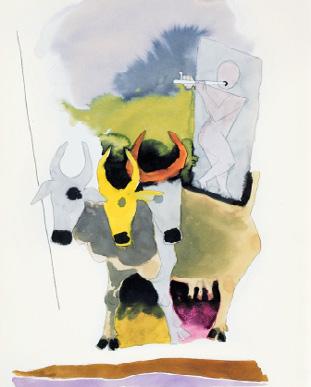

According to the latest International Data Corporation's (IDC) "Asia/Pacific Quarterly Mobile Phone Tracker", India’s smartphone market saw the highest-ever second quarter shipment of 36.9 million in the second quarter (Q2) this year.
Samsung registered a strong 16.6 per cent (YoY) growth in the second quarter, fueled by the newly-launched Galaxy A series across low and mid-price segments. Galaxy A10 and A2 Core have been among the top 5 models overall for the market.
Yamuna floods homes, thousands evacuated
With floodwaters of the Yamuna having swamped their homes, some 14,000 people have been moved to relief camps.
As monsoon rains pounded the upper reaches, neighbouring Haryana released water from the HathiniKund dam flooding the homes of those living near the Yamuna's banks.
Several farmers engaged in small-time farming near the Yamuna Khadar and Kisan Colony area in the national capital said they have lost all hopes of earning a livelihood with the rising Yamuna waters destroying their crops.
The Delhi government has set up 46 relief camps with 2,120 tents having electricity, water, food and toilets across the city.
Several people living in the area are refusing to move to the relief camps, preferring instead to come for meals and then return to their halfsubmerged houses.
The water discharged from the barrage - which provides drinking water to Delhinormally takes 72 hours to reach the capital, the official said.
The river flows through five districts of Delhi - North, North East, Shahdara East, Central and South East.
Mediterranean migrants in Himalayas: Roopkund bones study
Nestled deep in the Himalayas at 5,029 metres above sea level, Roopkund Lake is colloquially referred to as "Skeleton Lake" due to the remains of several hundred ancient humans scattered around its shores.
A study by an international team of scientists has now revealed that ancient DNA from mysterious skeletons found in and around the lake show Mediterranean migrants travelled to the Himalayas.
The Chhatrapati Shivaji Maharaj Terminus Railway Station is illuminated on the anniversary of Indian Independence Day in Mumbai, 15 August 2019.

The study involving 28 researchers from institutions in India, the US and Europe revealed that the skeletons belonged to three genetically distinct groups.
The study, published in popular science journal Nature Communications, covered 38 skeletons found in Roopkund Lake and once thought to have died during a single catastrophic event. However, researchers found that they died in multiple periods separated by at least 1,000 years.
Genome-wide ancient DNA reveals that 23 of the individuals had ancestry that falls within the range of variation of present-day South Asians. A further 14 had ancestry typical of the eastern Mediterranean while one individual was found with Southeast Asian-related ancestry.
According to Hyderabad-based Centre for Cellular and Molecular Biology (CCMB), which was part of the study, it was the first ancient DNA ever reported from India.
"Little was known about the origin of these skeletons, as they have never been subjected to systematic anthropological or archaeological scrutiny, in part due to the disturbed nature of the site, which is frequently affected by rockslides, and which is often visited by local pilgrims and hikers who have manipulated the skeletons and removed many of the artifacts," says the study.
"There have been multiple proposals to explain the origins of these skeletons. Local folklore describes a pilgrimage to the nearby shrine of the mountain goddess, Nanda Devi, undertaken by a king and queen and their many attendants, who "due to their inappropriate, celebratory behaviour" were struck down by the wrath of Nanda Devi. It has also been suggested that these are the remains of an army or group of merchants who were caught in a storm. Finally, it has been suggested that they were the victims of an epidemic."
The researchers analysed the remains using a series of bioarcheologicaltests, including ancient DNA, stable isotope dietary reconstruction, radiocarbon dating and osteological analysis.
76 skeletal samples (72 long bones and four teeth) were sampled at the Anthropological Survey of India, Kolkata. Skeletal sampling was performed in dedicated ancient DNA facilities at CCMB in Hyderabad. A subset of samples were further processed at Harvard
Medical School, Boston.
Only Sanskrit daily newspaper struggles to survive
As the country celebrated World Sanskrit Week to popularise the "language of the gods," which previous External Affairs Minister, the late Sushma Swaraj, claimed was a modern language fit for computers, the only Sanskrit daily of India, Sudharma, published from Mysore, is struggling for survival.
Economics apart, the number of patrons of this newspaper, celebrating its 50th anniversary, is dwindling. The management has now sought help from various government agencies which have shown little interest so far.
Sudharma was started by Pandit Varadaraja Iyengar, a Sanskrit scholar, in 1970, to reach out to those who loved the language and were interested in promoting it. These days, his son K.V. Sampath Kumar and his wife Jayalakshmi are continuing to keep the legacy alive.
The newspaper, an-A3-size, two-page and five-column-sheet, has around 3,000 subscribers, mostly institutions and public libraries, who receive the copies by post. The e-version has around 100,000 readers.
While newspapers in Hindi and other languages continue to do well, Sudharma seems to have run out of resources.
"That's because no state or central body comes forward to assist us in any way and the response from various organisations in the private sector is indifferent," says editor K.V. Sampath Kumar.
Jayalakshmi, who is well versed in Hindi, Tamil, Kannada, and English, believes Sanskrit is a great language. People use it from birth to death for conducting Vedic rituals and religious ceremonies right across the length and breadth of the country.
“India is united by Sanskrit, which is the mother language sustaining so many languages in the country. It is growing, and now, even IT professionals are finding it is useful,” she said.
Priced at Rs 1.75, the paper mostly contains articles on Vedas, yoga, religion as also on politics and culture, among others. Sudharma's modest office in Ramchandra Agrahara has been visited by Ministers, Governors, Shankaracharyas, and other dignitaries.
Being the Sanskrit and Yoga capital of India, Mysore has a fairly good strength of scholars. Interest in Ayurveda and alternative medicines has also led to an increase in the demand for Sanskrit learning centres.
Scholars say Sanskrit was considered the
"language of the gods" in India. Despite the contribution Sanskrit has made to Indian philosophical and literary traditions, vested interests have spread the impression that the language is dead, inaccessible and of negligible relevance to daily life. This is far from true.
For the publishers of Sudharma, the newspaper is not so much a profitable venture but a mission, and a demonstration of love for the language which is now gaining international recognition.
Sampath Kumar was honoured this month by the HRD Ministry for his contribution to the Sanskrit language at a function in New Delhi organised by the World Sanskrit Sansthan.
Rest in peace, Vidya Sinha
She was the girl next door for an entire generation of Bollywood fans. Long before Vidya Sinha became a household name for Gen Now viewers playing the soap grandma on shows such as Kkavyanjali, Qubool Hai and Kullfi Kumarr Bajewala, she rose to unlikely stardom in the seventies. In an era when the Bollywood heroine was getting a dash of emancipation and westernised oomph, Vidya was the sari-clad Bharatiyanaari who exuded resolve and resilience on screen.
Vidya Sinha was an exception in Hindi commercial cinema for more than just that. She was unconventional in her choices in life as well as career, and the way she balanced both. She was already married when she shot to stardom doing Rajnigandha in 1974, having married Venkateshwaran Iyer in 1974. The couple remained married till his death in 1996. Which means Vidya remained married all through her heydays as a star - something unthinkable back in the seventies, when actresses were known to marry in secret, since a marital status becoming public could affect stardom.
The quintessential Indian woman she represented became her USP, and she found ready roles in the genre of middle-of-theroad cinema, the seventies equivalent to the new-age multiplex movie, made on medium budget and flaunting no superstars, but banking entirely on content. Basu Chatterjee, a connoisseur of the genre, frequently cast her in his films.
Chatterjee's cinematic idiom blended humour with gentle drama that reflected a socio-cultural comment on the times and its people. Vidya, with her believable image as a girl next door, became a talisman of sorts for the filmmaker's works, along with actors as
Amol Palekar and Sanjeev Kumar, who also exuded a similar image of realism through their acting.
Vidya and Amol Palekar saw hits such as Rajnigandha (1974), Chhoti Si Baat (1976) and Safed Jhooth (1977). With Sanjeev Kumar she had two major hits in 1978, the family drama Tumhare Liye and BR Chopra's comedy Pati Patni Aur Woh.
The seventies in fact marked Vidya's top form. In 1977, she balanced a realistic entertainer as Gulzar's Kitaab (1977) with Raj N. Sippy's action thriller Inkaar, starring Vinod Khanna and based on Akira Kurosawa's High And Low.
Vidya Sinha is still recalled for her natural style of acting, in an era when being over-thetop with histrionics was considered the badge of success in commercial Hindi cinema. She owes her ease before the camera probably to two factors - she was born in a film family, and had a brief stint of modelling before entering films.
Her father was the screenwriter and producer Rana Pratap Singh, popularly known as Pratap A. Rana, who made films such as Parwana (1947), Vidya (1948) and Jeet (1949).
Her run-up to modelling was an outcome of being crowned Miss Bombay. The victory brought offers from several brands in its wake.
It was during this phase that Basu Chatterjee spotted her and cast her in his 1974 film Raja Kaka opposite Kiran Kumar. By the time he cast her again in Rajnigandha later in the same year, Vidya was already a star.
Not many know Vidya had a small role in Satyajit ray's 1962 classic Kanchejungha. She made a mark in a career where she played the heroine over just about 12 years.
By the eighties, trends were changing, and she had to find room for experimenting. An interesting departure in terms of image was Raj N. Sippy's 1981 action drama, Josh, which cast Vidya in a negative role.
Vidya's last prominent release on the big screen was the Salman Khan-starrer Bodyguard in 2011, where she had a supporting role. Lately, she had been one of Indian television's favourite screen grandmothers.
Realising her space in Bollywood was shrinking, Vidya gave it all up by the nineties. In 2001, she went for a second marriage with an Australia-based doctor named Bhimrao Salunkhe. The couple got divorced in 2009, after Vidya complained of domestic abuse.
IANS



